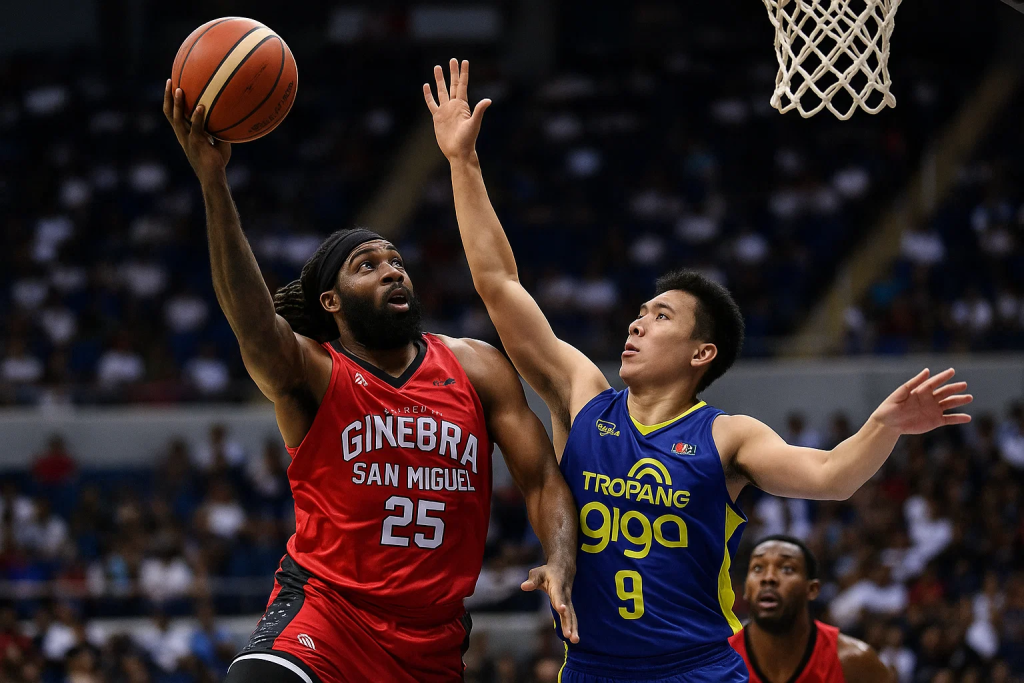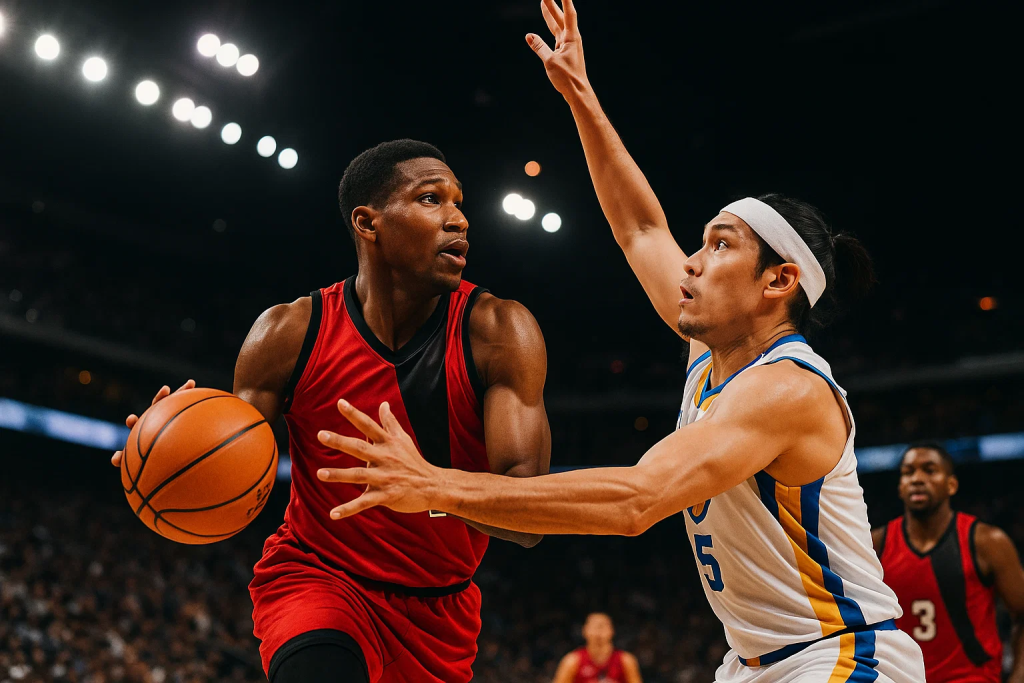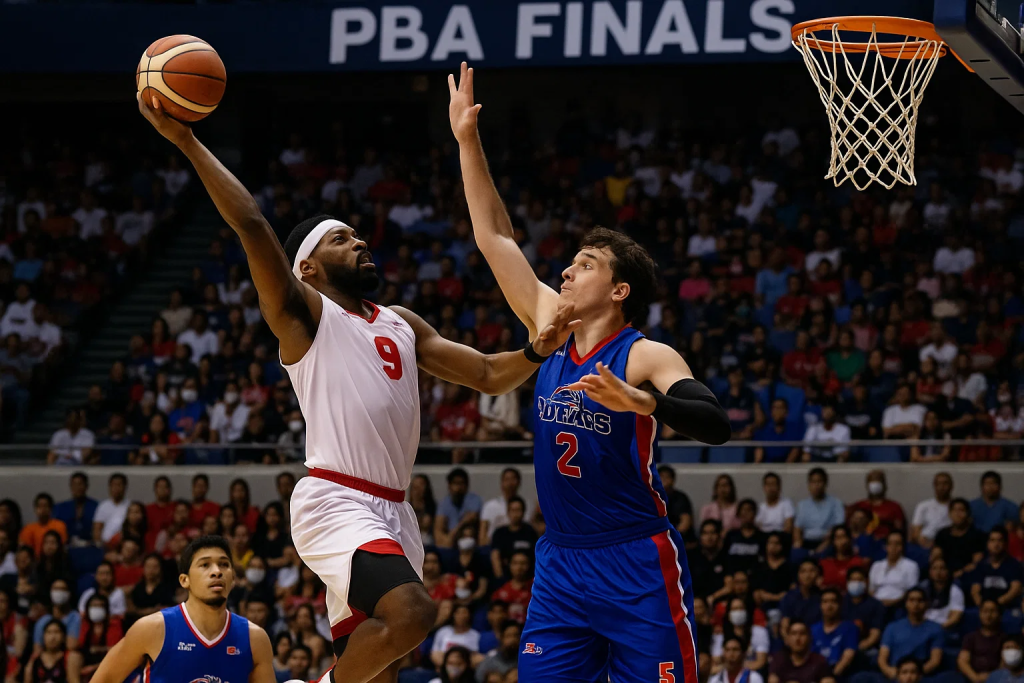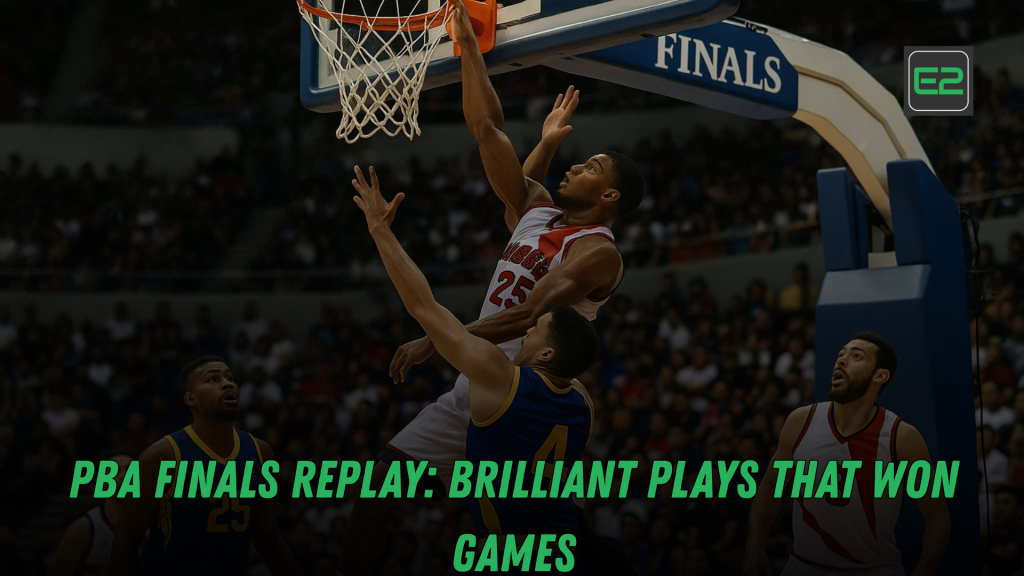Table of Contents
Why “Strategic Plays” Decide a PBA Championship
In the PBA, talent gets you to the Finals—but strategy is what hangs banners. Finals replays reveal a quiet truth: championships are usually decided by a handful of high-leverage possessions where one team executes a prepared set perfectly or springs a counter the opponent didn’t scout. Whether it’s a well-timed Spain pick-and-roll, a late-game hammer action for a corner three, or a triangle-and-2 to choke off a star, these micro-choices compound into macro-results.
This guide teaches you to watch PBA Finals replays like a coach. You’ll learn the actions that show up repeatedly in title games, the defensive counters that blunt them, how coaches script after-timeout magic, and how game theory—two-for-one timing, foul-up-three, and lineup staggering—translates to wins. Use it to deepen your viewing, build better analysis, or craft smarter practice plans for your team.

What Counts as a “Strategic Play” in the PBA?
A strategic play is not just a drawn diagram; it’s a context-aware decision:
- Action: The core set (e.g., horns twist, Spain PnR, elevator doors).
- Timing: When it’s deployed—clutch, two-for-one, after a dead ball.
- Personnel fit: Who screens, who handles, who lifts or drifts.
- Counter: What you run when the defense sniffs it out.
- Game script goal: Create a mismatch, force a rotation, steal a quick 3, burn a mismatch.
Finals replays show coaches chaining actions into mini-packages: the same entry but different finishes to punish specific coverages. Learn the package, not just the play.
The Offensive Actions That Consistently Win PBA Finals
Below are the PBA-relevant sets and why they’re brutal in high-leverage minutes.
1) Spain Pick-and-Roll (High PnR + Back Screen on the Roller)
- Why it works: Overloads help. The back screen on the diving big messes up tag rules, often yielding a dunk or a skip three.
- Signatures to watch on replay:
- Decoy Spain (no back screen, just lift the shooter to sell it).
- Short roll to the foul line and a slot cutter behind the help.
- Common counters: Switch the back screen (scram early); pre-switch the shooter’s defender; top-lock the shooter and funnel to weak.
2) Hammer Action to the Weak-Side Corner
- Why it works: The weak-side back screen turns a baseline drive into a corner 3 with help neutralized.
- Replay tells: Baseline attack from a 45° slot, weak-side big sets the back screen, the corner lifts then receives a dart pass.
- Typical PBA counter: Peel switch on the back screen + stunt from nail help to bait a float pass.
3) Horns Family (Horns Twist, Horns Flare, Horns DHO)
- Why it works: Two bigs at elbows create clean entries vs pressure and multiple reads: twist into re-screen, flare to shooter, DHO to attack a slow hedge.
- Replay tells: Early elbow catches, the non-screening big ghosts to the slot for instant pick-your-poison.
4) Ghost Screen into Pull-Up or Drive
- Why it works: In the PBA, many defenses pre-call their PnR coverage. A ghost (fake) screen defeats preparation, often yielding a clean pull-up 3.
- Counter: Switch on the call; jump the gap to take away the pull-up; top-lock the ghosting shooter.
5) Iverson Cuts to Shake the Primary Defender
- Why it works: Two staggered screens across the elbows free a creator to catch on the wing in rhythm. From there: quick PnR, handback, or iso vs cross-match.
- Counter: Lock-and-trail with the elbow big showing early body; scram switch if a small gets pinned.
6) Elevator Doors (Pin-In for a Pop Shooter)
- Why it works: Finals games often hinge on one clean look for your best shooter. Elevator doors give it—if timed with decoys (ghost inside to freeze the help).
- Counter: Top-lock early; switch the gates; bump the cutter on the entry.
7) Post Split & Split-Cut Variants
- Why it works: A capable post passer (import or skilled local big) forces help from the nail; the split-cut creates either a layup off a slip or a shooter pop.
- Counter: Three-quarter the post + early dig; switch the split and zone up weak side.
8) 21 Series (Pitch-Ahead DHOs)
- Why it works: Creates pace without fastbreak; flows into PnR with defense backpedaling.
- Counter: Jam the DHO with physical on-ball; “ICE” the side PnR to send baseline into help.
9) Chicago Action (Pin-Down into DHO)
- Why it works: Eliminates the defender’s angle; the DHO becomes a seam for pull-up or downhill.
- Counter: Top-lock the pin; switch the DHO; tag from the nail.
Defensive Schemes PBA Champions Use to Kill Your Favorite Sets
Defense wins the margins. In replays, note alignment, not just effort.
1) ICE (Blue) on Side Pick-and-Roll
- Goal: Keep the ball out of the middle; force baseline to loaded help.
- Keys on replay: On-ball jumps high foot; big drops to contain; weak-side low man on the roll; nail shows on the slot.
2) Drop Coverage with Peel/Tag Rules
- Goal: Protect the rim, concede the right pull-ups.
- Replay cues: On-ball fights over; big at the level-then-drop; weak-side tag then peel switch to deny kick-outs.
3) Switch Everything (Selective)
- Goal: Kill actions like Spain, elevators, hammer.
- Replay cues: Bigs switch early (pre-switch), off-ball scram to kick smalls out of post mismatches.
4) Hedge/Show and Recover
- Goal: Disrupt rhythm ball-handlers.
- Replay cues: Big shows chest; rear-view contest from guard; rotations behind must be on a string.
5) Box-and-1 / Triangle-and-2
- Goal: Star denials in clutch—force others to beat you.
- Replay cues: One chaser glued to the star; others packed; offense must screen the zone or flash the short corner.
6) Matchup Zones (2-3, 3-2 with Match Principles)
- Goal: Protect paint, challenge above the break.
- Replay cues: Zone looks, man principles on entries (bump the cutter, tag roller), X-out rotations to corners.
The PBA ATO Edge: After-Timeout and Inbound Plays (SLOB/BLOB)
Champions bank ATOs like timeouts are currency. In replays, pause after timeouts:
- SLOB staples:
- Horns entry into ghost for a pull-up.
- Stack inbound then slip when defenders top-lock.
- BLOB staples:
- Screen-the-screener for a quick 2.
- Lob with decoy back screen from your best shooter.
Scouting tip: If an ATO works once, watch for the counter later: same start, different finish.

PBA End-Game Tactics: Where One Decision Wins a Series
These are the PBA Finals “minigames” that flip trophies.
Two-for-One Management
- Concept: Shoot quickly enough to guarantee the last shot too.
- Replay tells: Quick set with a simple ghost or drag PnR; accept a B+ look to bank extra possession.
Foul-Up-Three (and When Not To)
- Standard: With <7 seconds and no shooting motion, many coaches foul.
- Replay tells: Who the offense inbounded to (weak FT shooter?); where the catch occurred (backcourt safer to foul).
Who Takes and Who Screens
- Rule of thumb: Your best shooter is your best screener late—his defender won’t help, so slips are open. It’s a Finals classic.
Timeout Economy
- Smart use: Save one to advance the ball after a defensive board; use early in a drought to reset your ATO package.
Personnel: How PBA Coaches Build Lineups for Winning Plays
- Import + lead guard synergy: Put your best roller with your best pull-up guard in Spain/drag PnR.
- Stretch-5 utility: Even a 33–35% three-point shooting big changes tag geometry—replays show help shrinking.
- 3-and-D wings: The real Finals currency: they close corners, switch, hit corner 3s out of hammer and drive-kick.
- Hide your weakest defender: Cross-match in transition; put him on a non-spacer; use peel switches behind him.
How to Watch a PBA Finals Replay Like a Coach (Step-by-Step)
- Map the first five set plays each team runs. These are tone-setters.
- Log every ATO (after timeouts, quarter breaks, reviews). Did it score?
- Time-stamp all hammer, Spain, horns. Did the defense change coverage?
- Record late-game possessions (last 4:00): entries, matchups, timeout usage.
- Chart shot quality (A, B, C grades): corner 3 or rim attempts are A; late clock contested long 2s are C.
- Note counters: same entry, new finish. Who adapted faster?
Use a simple sheet: [Time | Set | Result | Coverage | Counter next time]. By Game 2–3, you’ll predict coaches’ chess moves.
PBA Practice Design: Bringing Replay Lessons to the Court
- Install packages, not plays: Teach hammer + counter, Spain + decoy, horns + three endings.
- Defensive periodization: One day of ICE, one day of switch scram, one day of matchup zone X-outs.
- End-game lab: Daily 6-minute scrimmage with two-for-one, foul-up-three, advance/timeout scenarios.
- Role clarity: Identify late-game screener, inbounder, safety valve, and foul shooter.
Analytics Without the Jargon: What to Track From Replays
- Points per possession (PPP) by set family (Spain, horns, hammer).
- Shot profile: % at rim, corner 3s, above-the-break 3s, long 2s.
- Turnover types: Live-ball steals (lead to runouts) matter more than dead-ball.
- Rebounds by coverage: Does switch make you bleed offensive boards?
- Clutch net rating (last 5:00, ±5 points): Who wins when it’s tight?
Your goal isn’t perfect numbers; it’s evidence for rotation and play-calling.
Common Replay Patterns in PBA Finals (What Fans Always Miss)
- The “best shooter screens” trick shows up in every close game.
- Teams stack three looks from one entry—first scores, second draws a counter, third punishes the counter.
- The champion usually wins ATO battle by 4–8 points over a series.
- Corner defense decides titles. The team that closes and tags with discipline takes away hammer and lift-drift threes.
PBA Sample Breakdown: One Late-Game Possession (Educational, Generic)
- 00:28 left, up 1, ball at SLOB. Offense starts in horns.
- Action: Horns flare—shooter ghosts, slips to top; handler rejects, drives baseline.
- Weak-side: Hammer back screen springs corner.
- Defense: Peel switch on back screen; nail help stunts and recovers.
- Result: Baseline cut taken away; handler skip-passes to ghosting shooter—clean above-the-break 3.
- Takeaway: Even when hammer is covered, the ghost exit must be defended. Champions plan the second window.
PBA Content & SEO Structure You Can Copy (If You Publish Replays)
- Hero section: “PBA Finals Replay: The Winning Playbook.”
- Chapters: Offense, Defense, ATOs, End-Game, Replay Guide, Practice Plan, Analytics.
- On-page elements:
- Bulleted checklists, glossary (ICE, ghost, scram, X-out), and downloadable shot chart.
- Internal links to your team breakdowns, external links to general basketball concepts (no spoilers needed).
- CTA modules: “Download the Replay Worksheet,” “Subscribe for Weekly ATOs,” “Request a Team-Specific Breakdown.”
The Bottom Line: PBA Strategy Is a Habit, Not a Hail Mary
Titles don’t come from a miracle heave. They’re the product of rehearsed, modular actions that anticipate counters, discipline in coverage, plus sharp timeout economics. Replays expose the blueprint. Watch them deliberately and you’ll begin to see the series winner 3–4 possessions early.
The article explains how PBA championships are often decided by a handful of high-leverage possessions—and shows fans, analysts, and coaches how to read Finals replays like a bench strategist. It defines a “strategic play” as the fusion of action, timing, personnel fit, counter, and game script goal, then maps the offensive sets that repeatedly win titles:
Spain pick-and-roll (with back screen on the roller), hammer action (baseline drive to corner 3), the horns family (twist/flare/DHO versatility), ghost screens to beat pre-called coverages, Iverson cuts, elevator doors for shooters, post split reads, 21 series pitch-ahead DHOs, and Chicago action (pin-down into DHO). For each, it lists common counters (switch/scram, peel switches, top-locks, pre-switches) so viewers can spot adjustments in real time.
Defensively, champions toggle among ICE on side PnR, drop with peel/tag rules, selective switching (plus scram), hedge/show, box-and-1 and triangle-and-2, and matchup zones with X-out rotations—emphasizing alignment and weak-side rules over raw effort.
The ATO edge (after-timeout SLOB/BLOB packages) is highlighted as a hidden scoreboard; winners typically gain 4–8 points per series from ATO execution and counters. End-game game theory—two-for-one management, foul-up-three decisions, who screens vs who shoots, and timeout economy—is framed as “minigames” that flip trophies.

Personnel notes stress import + lead guard synergy in PnR, the geometric impact of a stretch-5, the value of 3-and-D wings, and methods to hide a weak defender with cross-matches and peel switches. A step-by-step replay method (log first five sets, every ATO, last four minutes; grade shot quality; track counters) helps readers see coaching chess moves.
Practice translation focuses on packages not plays, defensive periodization, and daily clutch labs. Lightweight analytics (PPP by set, shot profile, live-ball turnovers, rebound effects of switching, clutch net rating) turn observations into decisions. The piece closes with a CTA for team-specific breakdowns and an FAQ covering essential sets, horns popularity, quick study tips, and late-game schemes.
Strong Call-to-Action
Want a team-specific breakdown? Tell me your squad, the Finals year, and the game number. I’ll chart every Spain, hammer, horns variant, and ATO; grade shot quality; then hand you a one-page coaching report with practice drills and end-game scripts tailored to your roster.
Frequently Asked Questions (FAQ)
1) What is the single most important PBA Finals set to master?
There isn’t just one, but Spain pick-and-roll plus hammer weak-side show up constantly in clutch time. Learn both and their counters (scram on Spain; peel switch on hammer).
2) Why do teams run horns so often in the Finals?
Horns creates clean entries under pressure, offers multiple finishes (twist, flare, DHO), and lets coaches call audibles based on the defense’s first movement.
3) How do I tell if a team is winning the coaching battle?
Track ATO efficiency, two-for-one execution, and whether a team scores on a counter out of the same entry later in the game. Those are coaching fingerprints.
4) What’s the best way to study replays quickly?
Time-stamp first 5 plays, every ATO, and the last 4 minutes. Use a simple table (Set | Result | Coverage | Counter). You’ll capture 80% of the coaching story.
5) Which defensive scheme is safest late—switch, drop, or zone?
Context rules. Against dynamic shooters, switch + scram is reliable. If you lack switchable size, drop with peel rules can work. For cold-shooting lineups, a matchup zone steals a possession or two.
